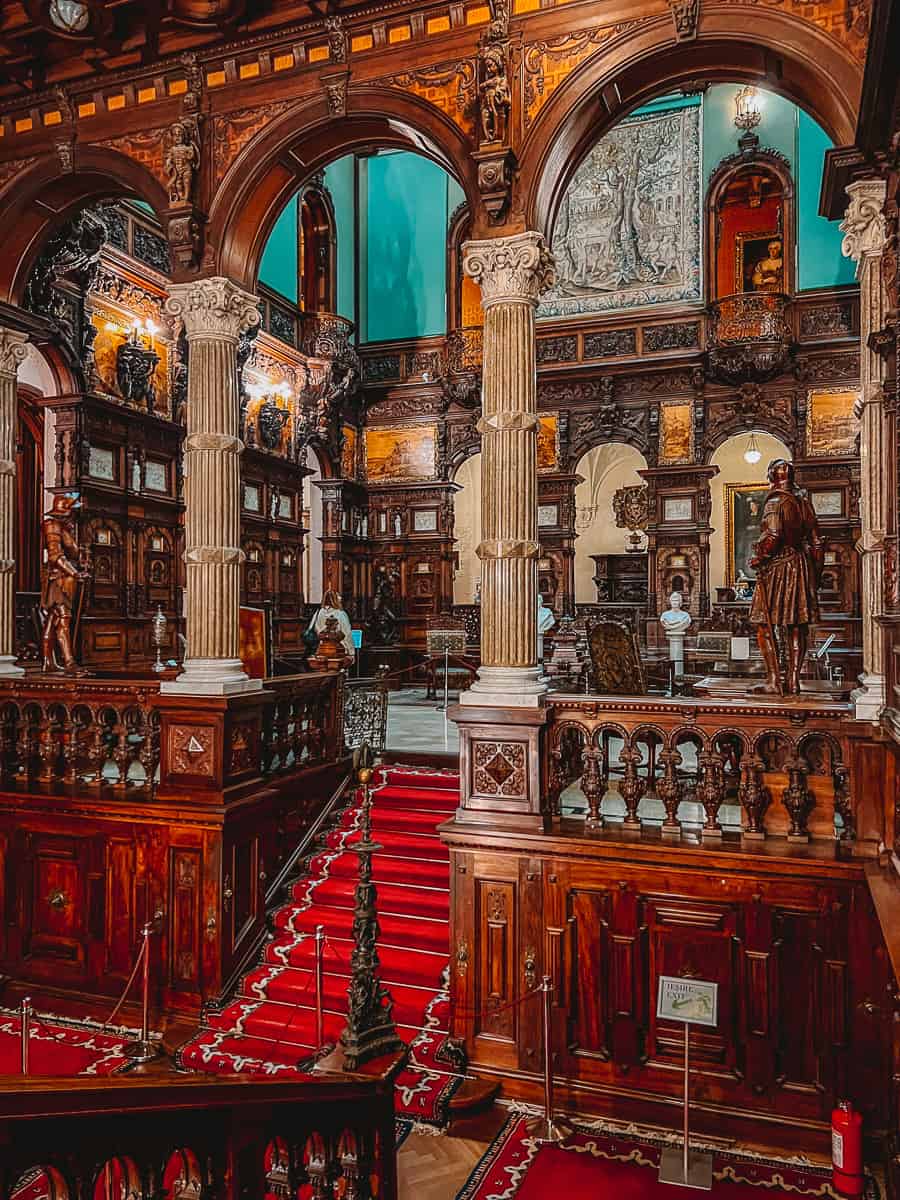Nestled in the southeastern Carpathian Mountains of Romania, Peleș Castle stands as a testament to Neo-Renaissance grandeur and architectural brilliance. Constructed between 1873 and 1914, this majestic palace was commissioned by King Carol I of Romania and inaugurated in 1883. Its location, amidst the serene beauty of the Royal Domain of Sinaia, reflects the king’s vision of a regal retreat that harmonizes with the natural splendor of the Carpathian landscape.
Location and Surroundings

Peleș Castle is situated in the Royal Domain of Sinaia, approximately 48 kilometers (30 miles) from Brașov and 124 kilometers (77 miles) from Bucharest. The castle complex includes three notable structures: Peleș Castle itself, Pelișor Castle, and the Foișor Hunting Lodge. These buildings are set against the picturesque backdrop of the Carpathian Mountains, creating a stunning ensemble that draws visitors from around the globe.
Historical Background

The origins of Peleș Castle trace back to 1866 when King Carol I first visited the site and was captivated by its scenic beauty. In 1872, the Crown acquired 5 square kilometers of land near the Piatra Arsă River, which was subsequently named the Royal Estate of Sinaia. The construction of Peleș Castle began on August 22, 1873, with the intent to create a royal hunting preserve and summer retreat.
The initial design proposals for the castle were dismissed by King Carol I for their lack of originality and excessive cost. German architect Johannes Schultz eventually won the commission with a design that combined various European architectural styles, particularly Italian elegance and German aesthetics. The castle’s construction saw significant contributions from architect Carol Benesch and later, Czech architect Karel Liman, who designed the towering central spire and other notable additions.

Despite interruptions during the Romanian War of Independence (1877–1878), the construction of Peleș Castle proceeded rapidly once resumed. In 1883, the castle was officially inaugurated with a grand ceremony attended by guests from across Europe, marking the completion of the royal residence.
Architectural Marvel
Peleș Castle, with its 3,200-square-meter (34,000 sq ft) floor plan, features over 170 rooms, each meticulously designed with distinct themes from various world cultures. The architectural style is a romantic blend of Neo-Renaissance and Gothic Revival, reminiscent of Bavaria’s Neuschwanstein Castle. The interior showcases Baroque influences with ornate woodwork and luxurious fabrics, reflecting the opulence of the era.

The castle’s diverse collection includes over 4,000 pieces of arms and armor, intricate Oriental rugs, fine porcelain, and hand-painted stained glass. Statues by Italian sculptor Raffaello Romanelli adorn the castle grounds, adding to the estate’s regal ambiance. The gardens, featuring seven Italian neo-Renaissance terrace gardens, are embellished with marble statues, fountains, and decorative elements.
Notable Visits and Cultural Impact

Throughout its history, Peleș Castle has hosted numerous distinguished guests, including Kaiser Franz Joseph I of Austria-Hungary, who praised its scenic beauty and artistic treasures. Artists like George Enescu and Sarah Bernhardt frequently visited, and the castle’s cultural significance was further highlighted by visits from international dignitaries such as Richard Nixon and Yasser Arafat.
The castle’s allure extends to popular culture, having been featured in films such as “The Brothers Bloom” and Netflix’s “A Christmas Prince” series. These portrayals have introduced Peleș Castle to a global audience, emphasizing its enchanting appeal and historical significance.
A New Chapter
Following the fall of Communism in Romania, Peleș Castle reopened to the public in 1990 after years of restricted access. Today, it is a major tourist attraction, drawing between 250,000 and 500,000 visitors annually. The castle, along with Pelișor Castle and the Foișor Lodge, continues to captivate audiences with its rich history and architectural splendor.
In 2006, the Romanian government returned the Royal Domain to King Michael I, and the castle is now leased to the Romanian state. Peleș Castle remains a symbol of Romania’s royal heritage and a testament to the country’s historical and cultural richness.
Conclusion
Peleș Castle stands as a remarkable example of Neo-Renaissance architecture and royal splendor, reflecting both the artistic vision of its creators and the grandeur of Romania’s royal past. Its breathtaking location, combined with its intricate design and rich history, makes it a cherished landmark in the Carpathian Mountains. As it continues to attract visitors and inspire awe, Peleș Castle endures as a symbol of Romania’s cultural heritage and architectural excellence.
